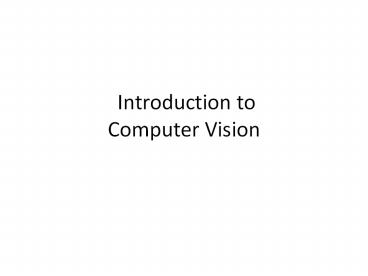Computer Vision - PowerPoint PPT Presentation
Title:
Computer Vision
Description:
this is science and technology how machine see. in this concept system see and understand images and videos this concept is used in multidisciplinary. this used by OCR... – PowerPoint PPT presentation
Number of Views:417
Title: Computer Vision
1
Introduction to Computer Vision
2
What is Computer Vision?
3
What is Computer Vision?
- Computer vision is the science and technology of
machines that see. - Concerned with the theory for building artificial
systems that obtain information from images. - The image data can take many forms, such as a
video sequence, depth images, views from multiple
cameras, or multi-dimensional data from a medical
scanner
4
Computer Vision
- Make computers understand images and videos.
What kind of scene? Where are the cars? How far
is the building?
5
Components of a computer vision system
Camera
Lighting
Computer
Scene
Srinivasa Narasimhans slide
6
Computer vision vs human vision
What we see
What a computer sees
7
Vision is really hard
- Vision is an amazing feat of natural
intelligence - Visual cortex occupies about 50 of Macaque brain
- More human brain devoted to vision than anything
else
Is that a queen or a bishop?
8
Vision is multidisciplinary
Computer Graphics
HCI
From wiki
9
Why computer vision matters
Health
Security
Safety
Fun
Comfort
Access
10
A little story about Computer Vision
In 1966, Marvin Minsky at MIT asked his
undergraduate student Gerald Jay Sussman to
spend the summer linking a camera to a computer
and getting the computer to describe what it
saw. We now know that the problem is slightly
more difficult than that. (Szeliski 2009,
Computer Vision)
11
A little story about Computer Vision
Founder, MIT AI project
In 1966, Marvin Minsky at MIT asked his
undergraduate student Gerald Jay Sussman to
spend the summer linking a camera to a computer
and getting the computer to describe what it
saw. We now know that the problem is slightly
more difficult than that.
12
A little story about Computer Vision
In 1966, Marvin Minsky at MIT asked his
undergraduate student Gerald Jay Sussman to
spend the summer linking a camera to a computer
and getting the computer to describe what it
saw. We now know that the problem is slightly
more difficult than that.
Image Understanding
13
Ridiculously brief history of computer vision
- 1966 Minsky assigns computer vision as an
undergrad summer project - 1960s interpretation of synthetic worlds
- 1970s some progress on interpreting selected
images - 1980s ANNs come and go shift toward geometry
and increased mathematical rigor - 1990s face recognition statistical analysis in
vogue - 2000s broader recognition large annotated
datasets available video processing starts
vision graphis vision for HCI internet
vision, etc.
Guzman 68
Ohta Kanade 78
Turk and Pentland 91
14
How vision is used now
- Examples of state-of-the-art
15
Optical character recognition (OCR)
- Technology to convert scanned docs to text
- If you have a scanner, it probably came with OCR
software
Digit recognition, ATT labs http//www.research.a
tt.com/yann/
License plate readers http//en.wikipedia.org/wiki
/Automatic_number_plate_recognition
16
Face detection
- Many new digital cameras now detect faces
- Canon, Sony, Fuji,
17
Smile detection
Sony Cyber-shot T70 Digital Still Camera
18
Object recognition (in supermarkets)
LaneHawk by EvolutionRobotics A smart camera is
flush-mounted in the checkout lane, continuously
watching for items. When an item is detected and
recognized, the cashier verifies the quantity of
items that were found under the basket, and
continues to close the transaction. The item can
remain under the basket, and with LaneHawk,you
are assured to get paid for it
19
Vision-based biometrics
How the Afghan Girl was Identified by Her Iris
Patterns Read the story wikipedia
20
Login without a password
Face recognition systems now beginning to appear
more widelyhttp//www.sensiblevision.com/
Fingerprint scanners on many new laptops, other
devices
21
Object recognition (in mobile phones)
- Point Find, Nokia
- Google Goggles
22
Special effects shape capture
The Matrix movies, ESC Entertainment, XYZRGB, NRC
23
Special effects motion capture
Pirates of the Carribean, Industrial Light and
Magic
24
Sports
Sportvision first down line Nice explanation on
www.howstuffworks.com http//www.sportvision.com/
video.html
25
Smart cars
Slide content courtesy of Amnon Shashua
- Mobileye wiki article
- Vision systems currently in high-end BMW, GM,
Volvo models - By 2010 70 of car manufacturers.
26
Google cars
http//www.nytimes.com/2010/10/10/science/10google
.html?refartificialintelligence
27
Vision-based interaction (and games)
Digimask put your face on a 3D avatar.
Nintendo Wii has camera-based IRtracking built
in. See Lees work atCMU on clever tricks on
using it tocreate a multi-touch display!
Game turns moviegoers into Human Joysticks,
CNET Camera tracking a crowd, based on this work.
28
Interactive Games Kinect
- Object Recognition http//www.youtube.com/watch?f
eatureivvfQ59dXOo63o - Mario http//www.youtube.com/watch?v8CTJL5lUjHg
- 3D http//www.youtube.com/watch?v7QrnwoO1-8A
- Robot http//www.youtube.com/watch?vw8BmgtMKFbY
- 3D tracking, reconstruction, and interaction
http//research.microsoft.com/en-us/projects/surfa
cerecon/default.aspx
29
Vision in space
NASA'S Mars Exploration Rover Spirit captured
this westward view from atop a low plateau where
Spirit spent the closing months of 2007.
- Vision systems (JPL) used for several tasks
- Panorama stitching
- 3D terrain modeling
- Obstacle detection, position tracking
- For more, read Computer Vision on Mars by
Matthies et al.
30
Industrial robots
Vision-guided robots position nut runners on
wheels
31
Mobile robots
NASAs Mars Spirit Rover http//en.wikipedia.org/w
iki/Spirit_rover
http//www.robocup.org/
Saxena et al. 2008 STAIR at Stanford
32
Medical imaging
Image guided surgery Grimson et al., MIT
3D imaging MRI, CT
33
Prerequisites
- A good working knowledge of C/C, Java or Matlab
- A good understand of math (linear algebra, basic
calculus, basic probability) - Willing to learn new stuffs (optimization,
statistical learning etc.)































